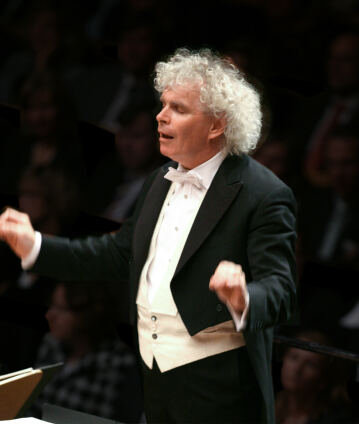Simon Rattle conducts Brahms’s Symphonies No. 3 and 4

The cycle of the complete Brahms symphonies conducted by Simon Rattle was the most important project of the Berliner Philharmoniker during the 2008/2009 season. Two of these works were heard here: the Third and Fourth Symphonies. Die Welt praised the performance as the “ecstatic apotheosis of what modern orchestral playing, fast reactions and concise interpretation can elicit from a work that has long been a classic”.
As difficult as it was for Johannes Brahms on his path to the symphony, overshadowed by the giant Beethoven, after his C minor debut in this genre was presented to the public in 1876 the spell seemed to be broken. The Second Symphony already appeared during the following year, and Nos. 3 and 4 were also premiered in comparatively quick succession in 1883 and 1885. After that, Brahms composed only one more work for large orchestra, his Double Concerto for Violin and Cello.
Thus, it is quite possible that the composer deliberately ended his symphonic work with the Fourth Symphony in E minor. His historical retrospection in the fourth movement, which takes up the Baroque model of the passacaglia, also suggests this. The unusually dense and intellectual conception initially caused the composer himself to doubt that it would find success with the public. With his characteristic odd self-irony he wrote to his close friend Elisabeth von Herzogenberg: “In general my pieces are unfortunately more agreeable than I am, and one finds less in them to correct?! But in these parts the cherries do not become sweet and edible – so if the thing doesn’t taste good to you, don’t bother yourself about it.” Posterity did not confirm the composer’s scepticism – the Fourth Symphony has long been one of the most popular compositions in the concert repertoire.
During their in-depth exploration of Brahms, in this concert from November 2008 Sir Simon Rattle and the Berliner Philharmoniker played the composer’s Fourth Symphony before the Third. In his Third Symphony Brahms achieves the unity between movements that was considered obligatory since Beethoven’s Ninth by, among other things, bringing the opening motif of the first movement back at the end of the finale. The theme of the Poco allegretto achieved a certain prominence in popular culture: it not only served as the theme music in the Ingrid Bergman film Goodbye Again but was also quoted extensively in Carlos Santana’s song Love of My Life.
© 2008 Berlin Phil Media GmbH
Artists
Our recommendations
- Sir Simon Rattle conducts a Mozart Gala at the 2005 New Year’s Eve Concert
- Simon Rattle conducts Schumann and Dutilleux
- Season opening 2016: Simon Rattle conducts Mahler’s Seventh Symphony
- Sir Simon Rattle and Dianne Reeves at the 2003 New Year’s Eve Concert
- Simon Rattle conducts Wagner
- Simon Rattle conducts Sibelius’s Symphonies Nos. 5–7